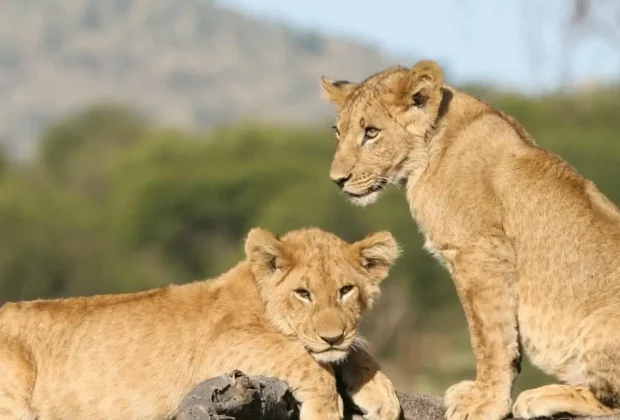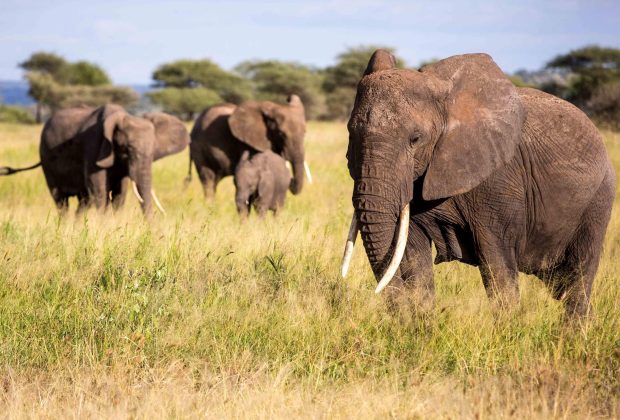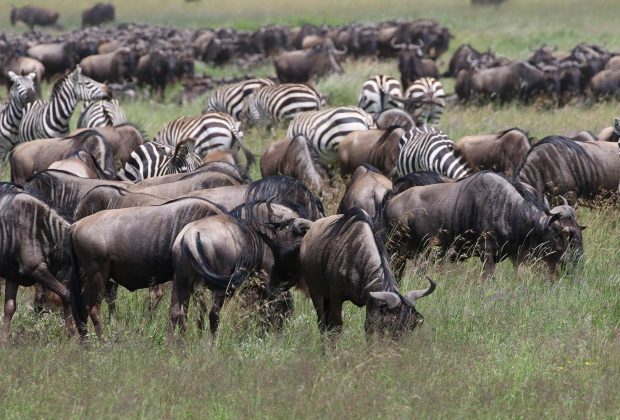5 Days
Serengeti Wildebeest Migration
Price in USD
$ 2260/pp * Sharing
Overview
5 Days Serengeti Wildebeest Migration
The south-eastern part of the Serengeti, the Ndutu area, is rich in wildlife all year round, but wildlife numbers reach a peak between December and April. Huge herds of wildebeests and zebras are attracted by the seasonal rains. In this period, the best area for game viewing is the plains around Lake Ndutu, where the wildebeest herds are concentrated. Most calves are born in January and February, around 8,000 per day. The short grass plains offer them some safety, as predators can be spotted more easily. Nevertheless, as happens in nature, these young wildebeest attract many hungry predators, such as lions, cheetahs, leopards and hyenas. Other species such as gazelles and zebras also give birth and use the wildebeest calves as cover to divert attention from their own young. The area also caters for birdwatchers; you can see, Ostriches, Vultures, Marabou stork. Bustards, Shrikes, Super fowls, Weaves, Lovebirds, Flamingoes, Water birds herons, are the popular birds you find in this region.
5 Days Serengeti Wildebeest Migration
After breakfast drive to Ndutu area where you will have to witness the migration of wildebeest and zebra. At the end of December, the great migration usually arrives with its 2 million animals
in Ndutu. Wildebeests, zebras and gazelles come here to give birth to their calves and stay
here until April. Thousands of animals are born every day from December to March. The
grass in this area is rich in nutrients for young animals. And because it is short, the adults
can spot approaching predators from far. It is therefore a safe place to raise young zebras
and wildebeests. Ndutu is a very beautiful region and rich in wild animals. In addition, it is
the only nature reserve in Tanzania where you are allowed to drive off-road. This allows
you to get very close to the animals. Many predators are attracted by the calving happening here and roam this vast Overnight at kenzan camp
Itinerary
After breakfast drive to Ndutu area where you will have to witness the migration of wildebeest and zebra. At the end of December, the great migration usually arrives with its 2 million animals in Ndutu. Wildebeests, zebras and gazelles come here to give birth to their calves and stay here until April. Thousands of animals are born every day from December to March. The grass in this area is rich in nutrients for young animals. And because it is short, the adults can spot approaching predators from far. It is therefore a safe place to raise young zebras and wildebeests. Ndutu is a very beautiful region and rich in wild animals. In addition, it is the only nature reserve in Tanzania where you are allowed to drive off-road. This allows you to get very close to the animals. Many predators are attracted by the calving happening here and roam this vast Overnight at Kenzan Camp.
Early morning game drive with the breakfast boxes to have more experience The best game viewing spot is around Lake Ndutu, where enormous herds congregate. It is a shallow alkaline lake that is located on the eastern border of Serengeti national park. In 1973, the shores of lake Ndutu were the location of an archaeological excavation site about 140 square meters that led to the discovery of the Ndutu cranium and several remains of tools from over 500.000 years ago. Today it serves as a water source for the animals and shares the same basin as lake Masek that is located a short distance east of it – but inside Ngorongoro conservation area. The forests and granite Kopjes around Lake Ndutu are also home to lots of game outside of the migration months. 3 Night Overnight at Kenzan Camp.
After breakfast we will have the game drive at ndutu area then we will drive to Karatu overnight at Marera Valley Lodge.
After breakfast at the lodge, drive to Mto wa Mbu for a cultural visit to the local women and learn how they do their daily activities including farming and small women micro financing groups. You will have the local African food. After lunch, drive back to Arusha Airport or Kilimanjaro Airport.
Includes
Includes
- Arrival and Departure transfers
- Accommodation as indicated (2 people sharing a double room with 1 or 2 separate beds. Please let us know your preference at the time of booking)
- Activities and meals as indicated (B=Breakfast, L=Lunch, D=Dinner)
- All Park fees and government taxes
- Services of professional English-speaking driver-guide
- Game drives in Land Rover or Land Cruiser with pop-up or flip-flop roof tops and guarantee of a window seat
- Bottled water while on safari
- Unlimited mileage on the safari
- Maximum of 6/7 passengers in the safari vehicles
Excludes
Excludes
- International airfare
- Items of a personal nature such as passport, visa and traveler’s insurance
- Tips to driver-guide
- A Masai Village visit for $ 50/vehicle
- Olduvai Gorge Museum for $36 pp
- Night game drive for $45 /pp
- Walking safari at rim of Ngorongoro Crater for $60 pp
- Balloon safari for $599 pp
Includes
- Arrival and Departure transfers
- Accommodation as indicated (2 people sharing a double room with 1 or 2 separate beds. Please let us know your preference at the time of booking)
- Activities and meals as indicated (B=Breakfast, L=Lunch, D=Dinner)
- All park fees and government taxes
- Services of professional English-speaking driver-guide
- Game drives in Land Rover or Land Cruiser with pop-up or flip-flop roof tops and guarantee of a window seat
- Bottled water while on safari
- Unlimited mileage on the safari
- Maximum of 6/7 passengers in the safari vehicles
Excludes
- International airfare
- Items of a personal nature such as passport, visa and traveler’s insurance
- Tips to driver-guide
- A Masai Village visit for $ 50/vehicle
- Olduvai Gorge Museum for $36 pp
- Night game drive for $45 /pp
- Walking safari at rim of Ngorongoro Crater for $60 pp
- Balloon safari for $599 pp
The Great Migration
Between June and October, travelers can witness this epic event: the clouds of dust, hooves pummeling the earth, the grunts and splashing of herds crossing the river — some inevitably falling prey to the waiting crocodiles. But that’s not all. On the vast Serengeti plains, you can spot cheetahs scanning from the top of a termite mound, lions beginning their prowl at dusk and herds of browsing elephants moving from tree to tree. River crossings are seen in the northern Serengeti, but outside migration season, these plains are largely free of safari-goers making it a great time to travel. The wildebeest herds gather in the south from December to February to feed on the lush grass and drop their young. And in the east, you’ll find a high concentration of lion, leopard and cheetahs. The Serengeti is an excellent year-round destination, though there are events — for example, the wildebeest river crossings — that are only seen at certain times of the year. The mobile camps move around the Serengeti with the herds, but still there is permanent lodges.
Migration Seasons
The Great Migration moves in a continuous cycle around the Serengeti and Kenya’s Masai Mara. The most popular time to see the herds is when they cross the Mara and Grummet rivers from June to October, but another great time to visit is January to March, when the wildebeest are calving in the south.
The Serengeti from November to May
Rainy Seasons March to May (long rains) and November to December (short rains)
Min Temperature Range 11°C-14°C / 52°F-57°F Peak Of Wet Season
QUESTION
The Great Migration is in May and June
Once the rainy season is over, the south and east plains of the Serengeti dry out, prompting the beginning of the Migration. This usually starts in April or May when herds begin to move north and west, although not always as one cohesive group.
1st July to 15th July: The Western Corridor and Lobo in the northern heart of the park. The rich grasses of the western corridor will keep herds for longer than many people expect, but early July usually sees the Great Migration pushing up through Lobo and into the northern Serengeti.
It is stupendous to see hundreds of thousands of animals moving all together. Because so many animals rely on wildebeest and zebra for food, the Migration attracts many other species while moving through the landscape, making for unique sightings of diverse species.
They begin to follow the rain pattern. Where there will be fresh food and water. The migration may change from year to year due to the unpredictability of the weather. Around 2 million wildebeest head out on the long journey along with zebras, eland, gazelles and impalas.
For the 2022 and 2023 seasons we recommend planning your travel for mid July as this is when the migration typically starts proper with the larger herds of wildebeest starting the move into Masai Mara. The migration takes place till end of August, before declining into mid-September.
Each year, roughly between May and December, millions of wildebeest, zebra, and gazelle begin a roundtrip journey between Tanzania’s Serengeti National Park and Kenya’s Maasai Mara. With hungry predators following their every move, it sets the scene for an unforgettable safari experience.18 Feb 2023.
Visit the famous Serengeti, home to an abundance of wildlife as well as the impressive wildebeest migration. And the striking Ngorongoro Crater, a natural wonder with the world’s highest concentration wildlife





